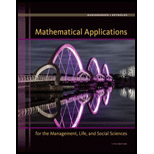
Concept explainers
(a)
To calculate: The probability that a ball chosen at random from the box is a baseball when,
(b)
To calculate: The probability that a ball chosen at random from the box is a tennis ball when,
(c)
To calculate: The probability that a ball chosen at random from the box is not a softball when,
(d)
To calculate: The probability that a ball chosen at random from the box is a hand ball when,
Want to see the full answer?
Check out a sample textbook solution
Chapter 7 Solutions
Mathematical Applications for the Management, Life, and Social Sciences
- The graph of 3 (x² + y²)² = 100 (x² - y²), shown in the figure, is a lemniscate of Bernoulli. Find the equation of the tangent line at the point (4,2). АУ -10 10 Write the expression for the slope in terms of x and y. slope =arrow_forwardUse a geometric series to represent each of the given functions as a power series about x=0, and find their intervals of convergence. a. f(x)=5/(3-x) b. g(x)= 3/(x-2)arrow_forwardPage of 2 ZOOM + 1) Answer the following questions by circling TRUE or FALSE (No explanation or work required). i) If A = [1 -2 1] 0 1 6, rank(A) = 3. (TRUE FALSE) LO 0 0] ii) If S = {1,x,x², x³} is a basis for P3, dim(P3) = 4 with the standard operations. (TRUE FALSE) iii) Let u = (1,1) and v = (1,-1) be two vectors in R². They are orthogonal according to the following inner product on R²: (u, v) = U₁V₁ + 2U2V2. ( TRUE FALSE) iv) A set S of vectors in an inner product space V is orthogonal when every pair of vectors in S is orthogonal. (TRUE FALSE) v) Dot product of two perpendicular vectors is zero. (TRUE FALSE) vi) Cross product of two perpendicular vectors is zero. (TRUE FALSE) 2) a) i) Determine which function(s) are solutions of the following linear differential equation. - y (4) — 16y= 0 • 3 cos x • 3 cos 2x -2x • e • 3e2x-4 sin 2x ii) Find the Wronskian for the set of functions that you found from i) as the solution of the differential equation above. iii) What does the result…arrow_forward
- An object of mass 4 kg is given an initial downward velocity of 60 m/sec and then allowed to fall under the influence of gravity. Assume that the force in newtons due to air resistance is - 8v, where v is the velocity of the object in m/sec. Determine the equation of motion of the object. If the object is initially 500 m above the ground, determine when the object will strike the ground. Assume that the acceleration due to gravity is 9.81 m/sec² and let x(t) represent the distance the object has fallen in t seconds. Determine the equation of motion of the object. x(t) = (Use integers or decimals for any numbers in the expression. Round to two decimal places as needed.)arrow_forwardEarly Monday morning, the temperature in the lecture hall has fallen to 40°F, the same as the temperature outside. At 7:00 A.M., the janitor turns on the furnace with the thermostat set at 72°F. The time constant for the building is = 3 hr and that for the building along with its heating system is 1 K A.M.? When will the temperature inside the hall reach 71°F? 1 = 1 hr. Assuming that the outside temperature remains constant, what will be the temperature inside the lecture hall at 8:30 2 At 8:30 A.M., the temperature inside the lecture hall will be about (Round to the nearest tenth as needed.) 1°F.arrow_forwardFind the maximum volume of a rectangular box whose surface area is 1500 cm² and whose total edge length is 200 cm. cm³arrow_forward
- Find the minimum cost of a rectangular box of volume 120 cm³ whose top and bottom cost 6 cents per cm² and whose sides cost 5 cents per cm². Round your answer to nearest whole number cents. Cost = cents.arrow_forwardFind a polynomial with integer coefficients that satisfies the given conditions. T(x) has degree 4, zeros i and 1 + i, and constant term 12.arrow_forwardFind the absolute extrema of the function f(x, y) = x² + y² - 3x-3y+3 on the domain defined by x² + y² <9. Round answers to 3 decimals or more. Absolute Maximum: Absolute Minimum:arrow_forward
 Holt Mcdougal Larson Pre-algebra: Student Edition...AlgebraISBN:9780547587776Author:HOLT MCDOUGALPublisher:HOLT MCDOUGAL
Holt Mcdougal Larson Pre-algebra: Student Edition...AlgebraISBN:9780547587776Author:HOLT MCDOUGALPublisher:HOLT MCDOUGAL Algebra and Trigonometry (MindTap Course List)AlgebraISBN:9781305071742Author:James Stewart, Lothar Redlin, Saleem WatsonPublisher:Cengage Learning
Algebra and Trigonometry (MindTap Course List)AlgebraISBN:9781305071742Author:James Stewart, Lothar Redlin, Saleem WatsonPublisher:Cengage Learning College AlgebraAlgebraISBN:9781305115545Author:James Stewart, Lothar Redlin, Saleem WatsonPublisher:Cengage Learning
College AlgebraAlgebraISBN:9781305115545Author:James Stewart, Lothar Redlin, Saleem WatsonPublisher:Cengage Learning- Algebra & Trigonometry with Analytic GeometryAlgebraISBN:9781133382119Author:SwokowskiPublisher:Cengage





